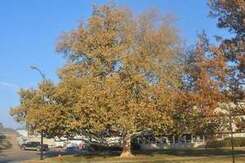
Marcescence (mar-CESS-enss) is defined by leaves that wither but do not detach from the plant. When the temperature drops quickly, as we have experienced this fall, many trees didn’t have time to develop an abscission layer at the base of each leaf. The abscission layer is what separates the leaf from the tree and prompts it to fall to the ground. Although marcescence does not harm the tree on its own it may indicate damage has occurred to the tree.
The sharp drop in temperature may have caused damage to the phloem and cambium tissues beneath the bark. The phloem is responsible for carrying food throughout the tree, including to the roots, and the cambium produces new phloem. If these tissues are killed, the roots cannot receive food necessary for survival. Since the roots have some energy reserves available, the tree will not die immediately. Once the reserves are used up, death is imminent, typically the summer after the damage occurred. The xylem is the structure in the tree that carries water from the soil throughout the plant. Since it is not damaged in this process the tree will continue to receive water which will help maintain life until the roots run out of reserves.
Another complication that can arise from marcescence is if we experience a heavy snow or ice storm. The weight of snow and ice that can accumulate on the leaves along with windy conditions can cause branches to break.
If you are seeing trees with marcescence nothing needs to be done now except prevent further stress. Trees should enter winter with moist soil. Without knowing the extent of the damage to the tree tissue it is impossible to know what the end result will be. If only a small portion of the tissue was killed the tree may still recover. (Cynthia Domenghini)
 RSS Feed
RSS Feed
